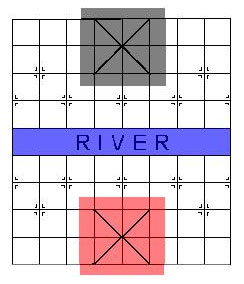

| The Basic Rules: |
|
|
| The Board: Chinese Chess board is made of 10 horizontal lines and 9 vertical lines. The pieces are placed on the intersections of the lines which are also known as points. |
 |
 |
| The area shaded in red is the red palace,
and the area in black is the black palace. The various "L" shaped markings
indicate where the pawns and cannons start off at.
|
||||||||||||||||
| The Pieces: Note that the red and black pieces may have different images, however they move in the same way.
|
||||||||||||||||
Other rules
The rules vary slightly in different competitions as they may add in maximum number of rules before drawing. The full Asian rules are much more complex to and was developed by the Hong Kong Chinese Chess Association (HKCCA) in 1979 and officially became a standard rule in 1989. The full set of rules could be found here. |